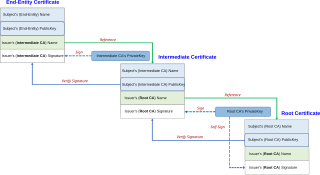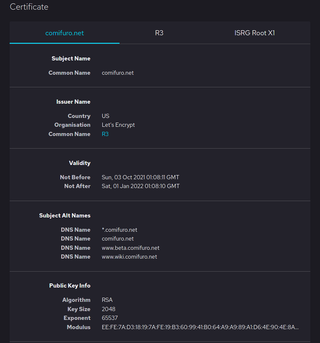X.500 is a series of computer networking standards covering electronic directory services. The X.500 series was developed by the Telecommunication Standardization Sector of the International Telecommunication Union (ITU-T). ITU-T was formerly known as the Consultative Committee for International Telephony and Telegraphy (CCITT). X.500 was first approved in 1988. The directory services were developed to support requirements of X.400 electronic mail exchange and name lookup. The International Organization for Standardization (ISO) and International Electrotechnical Commission (IEC) were partners in developing the standards, incorporating them into the Open Systems Interconnection suite of protocols. ISO/IEC 9594 is the corresponding ISO/IEC identification.

A public key infrastructure (PKI) is a set of roles, policies, hardware, software and procedures needed to create, manage, distribute, use, store and revoke digital certificates and manage public-key encryption. The purpose of a PKI is to facilitate the secure electronic transfer of information for a range of network activities such as e-commerce, internet banking and confidential email. It is required for activities where simple passwords are an inadequate authentication method and more rigorous proof is required to confirm the identity of the parties involved in the communication and to validate the information being transferred.
In cryptography, a public key certificate, also known as a digital certificate or identity certificate, is an electronic document used to prove the validity of a public key. The certificate includes the public key and information about it, information about the identity of its owner, and the digital signature of an entity that has verified the certificate's contents. If the device examining the certificate trusts the issuer and finds the signature to be a valid signature of that issuer, then it can use the included public key to communicate securely with the certificate's subject. In email encryption, code signing, and e-signature systems, a certificate's subject is typically a person or organization. However, in Transport Layer Security (TLS) a certificate's subject is typically a computer or other device, though TLS certificates may identify organizations or individuals in addition to their core role in identifying devices. TLS, sometimes called by its older name Secure Sockets Layer (SSL), is notable for being a part of HTTPS, a protocol for securely browsing the web.
In cryptography, X.509 is an International Telecommunication Union (ITU) standard defining the format of public key certificates. X.509 certificates are used in many Internet protocols, including TLS/SSL, which is the basis for HTTPS, the secure protocol for browsing the web. They are also used in offline applications, like electronic signatures.

In cryptography and computer security, a root certificate is a public key certificate that identifies a root certificate authority (CA). Root certificates are self-signed and form the basis of an X.509-based public key infrastructure (PKI). Either it has matched Authority Key Identifier with Subject Key Identifier, in some cases there is no Authority Key identifier, then Issuer string should match with Subject string. For instance, the PKIs supporting HTTPS for secure web browsing and electronic signature schemes depend on a set of root certificates.
In cryptography, a certificate authority or certification authority (CA) is an entity that stores, signs, and issues digital certificates. A digital certificate certifies the ownership of a public key by the named subject of the certificate. This allows others to rely upon signatures or on assertions made about the private key that corresponds to the certified public key. A CA acts as a trusted third party—trusted both by the subject (owner) of the certificate and by the party relying upon the certificate. The format of these certificates is specified by the X.509 or EMV standard.

Verisign Inc. is an American company based in Reston, Virginia, that operates a diverse array of network infrastructure, including two of the Internet's thirteen root nameservers, the authoritative registry for the .com, .net, and .name generic top-level domains and the .cc country-code top-level domains, and the back-end systems for the .jobs and .edu sponsored top-level domains.

Gen Digital Inc. is a multinational software company co-headquartered in Tempe, Arizona and Prague, Czech Republic. The company provides cybersecurity software and services. Gen is a Fortune 500 company and a member of the S&P 500 stock-market index. The company also has development centers in Pune, Chennai and Bangalore. Its portfolio includes Norton, Avast, LifeLock, Avira, AVG, ReputationDefender, and CCleaner.
CAcert.org is a community-driven certificate authority that issues free X.509 public key certificates. CAcert.org relies heavily on automation and therefore issues only Domain-validated certificates.
CyberTrust was a security services company formed in Virginia in November 2004 from the merger of TruSecure and Betrusted. Betrusted previously acquired GTE Cybertrust. Cybertrust acquired a large stake in Ubizen, a European security services firm based in Belgium, to become one of the largest information security firms in the world. It was acquired by Verizon Business in 2007. In 2015, the CyberTrust root certificates were acquired by DigiCert, Inc., a leading global Certificate Authority (CA) and provider of trusted identity and authentication services.
GeoTrust is a digital certificate provider. The GeoTrust brand was bought by Symantec from Verisign in 2010, but agreed to sell the certificate business in August 2017 to private equity and growth capital firm Thoma Bravo LLC. GeoTrust was the first certificate authority to use the domain-validated certificate method which accounts for 70 percent of all SSL certificates on the Internet. By 2006, GeoTrust was the 2nd largest certificate authority in the world with 26.7 percent market share according to independent survey company Netcraft.
GlobalSign is a certificate authority and a provider of internet identity and security products. As of January 2015, Globalsign was the 4th largest certificate authority in the world, according to Netcraft.

DigiCert, Inc. is a digital security company headquartered in Lehi, Utah. DigiCert provides public key infrastructure (PKI) and validation required for issuing digital certificates or TLS/SSL certificates, acting as a certificate authority (CA) and trusted third party.
The Certification Authority Browser Forum, also known as the CA/Browser Forum, is a voluntary consortium of certification authorities, vendors of Internet browser and secure email software, operating systems, and other PKI-enabled applications that promulgates industry guidelines governing the issuance and management of X.509 v.3 digital certificates that chain to a trust anchor embedded in such applications. Its guidelines cover certificates used for the SSL/TLS protocol and code signing, as well as system and network security of certificate authorities.
DigiNotar was a Dutch certificate authority owned by VASCO Data Security International, Inc.
Convergence was a proposed strategy for replacing SSL certificate authorities, first put forth by Moxie Marlinspike in August 2011 while giving a talk titled "SSL and the Future of Authenticity" at the Black Hat security conference. It was demonstrated with a Firefox addon and a server-side notary daemon.

The Certificate Authority Security Council (CASC) is a multi-vendor industry advocacy group created to conduct research, promote Internet security standards and educate the public on Internet security issues.
Certificate Transparency (CT) is an Internet security standard for monitoring and auditing the issuance of digital certificates.

A domain validated certificate (DV) is an X.509 public key certificate typically used for Transport Layer Security (TLS) where the domain name of the applicant is validated by proving some control over a DNS domain. Domain validated certificates were first distributed by GeoTrust in 2002 before becoming a widely accepted method.
Trustico is a dedicated SSL certificate provider, They are headquartered in the United Kingdom.







